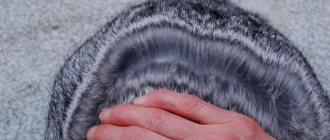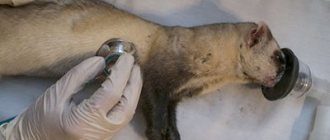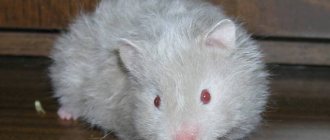One of the most popular dog breeds all over the world is the German Shepherd. Bred for military service, they show remarkable qualities in peaceful life: intelligence, devotion, obedience, and people-oriented behavior. The German Shepherd is bred to guard the home, as a companion at work and on walks; they are indispensable in rescue squads and the police. How long do German Shepherds live? Is it possible to provide a dog with a long and comfortable life? Let's look at these questions in more detail.
Life expectancy for boys and girls
The life expectancy of female and male German Shepherds is almost the same . Their minimum lifespan is 5-7 years.
But usually “Germans” live about 10-14 years. Of course, there are also long-livers, but such cases are quite rare. Their life lasts 15-17 years.
Males live 1.5-2 years less than females.
Expert opinion
Kozhevin Semyon Kirillovich
Expert dog handler.
“Most of the dogs of this breed live about 12 years. Long-livers are very rare, and these are those dogs that in their youth led a fairly active lifestyle and were on a strict diet. These are representatives of the exhibition line. If your dog has lived with you for less than 10 years, then this is a signal that something in its maintenance was wrong. Because the German Shepherd has a genetically determined life expectancy of at least 12 years.”
Depending on the type
Life expectancy does not depend on the type of German Shepherd - it directly depends on care.
But many years of experience have proven that dogs with rare coat colors have the greatest endurance, and therefore greater longevity.
Dogs with a color that disqualifies the standard, on the contrary, have lower vitality rates in old age. This occurs due to a mutation at the gene level, because their colors are not typical for a German shepherd.
Other factors affecting lifespan
Dog breeders have noted that uncastrated dogs live less than operated dogs. Male dogs are castrated at about one year of age, girls are taken for surgery after their first heat. If the shepherd is involved in breeding, then the bitch is not recommended to give birth after 6 years. The average age of a male dog used for mating is from 2.5 to 7 years.
When planning to buy a puppy, you should pay attention not only to the health and character of the parents, but also to the life expectancy of the dog’s parents. As a rule, longevity is a hereditary factor. A comfortable psychological atmosphere in the family is of great importance. A friendly attitude towards the dog, close contact and communication will help your pet avoid stress and live a long, joyful life.
Even the longest life of a pet is much shorter than a human's, this must be accepted. Communicating with a beloved dog for 15-20 years, a person receives bright positive emotions and gives joy to his pet. By approaching the care of your animal responsibly, you can enjoy companionship for many years.
How many live on the street and at home?
German Shepherds that live outdoors have a longer lifespan than those that live indoors.
This is due to the characteristics of the breed itself. Germans need physical activity, in which it is difficult and impossible to limit them, as well as mental activity, which manifests itself in training.
If you take away these aspects of your dog's life, it will have a negative impact on their physical and mental functioning.
The dog may become aggressive, its muscles will begin to weaken, and it will no longer be able not only to stand up for itself, but also to protect its owner.
If a German Shepherd is constantly kept in an enclosure on the street, this will lead to the same consequences.
Many dog breeds, on the contrary, feel more comfortable indoors, but the German Shepherd is not one of them. It is better and healthier for her to be outside - she is not afraid of rain and cold because of her dense undercoat and good coat.
Therefore, we can say with confidence that dogs living in the courtyard of a private house live much longer than those who have to huddle in an apartment.
But this does not mean at all that a German Shepherd cannot live indoors . Just provide her with the right amount of physical and mental stress.
Health
Of course, German Shepherds also get sick, sometimes very seriously. But if we compare it with other pets, including dogs of other breeds, we can say that these pets bother their owners much less often. It's all about good health and good immunity.
True, all this needs to be supported. Poor nutrition and living conditions that do not meet recommendations lead to the dog developing a certain disease. This breed is characterized by skin ailments, and all because it naturally has a poorly protected epidermis. Therefore, various dermatitis, rashes, seborrhea, scabies, etc. arise among the Germans with enviable consistency.
Poor nutrition and living conditions that do not meet recommendations lead to the dog developing a certain disease.
Representatives of this breed are also susceptible to various orthopedic diseases, primarily the following:
- osteochondrosis;
- joint dysplasia;
- hypertrophic osteodystrophy;
- spondylomyelopathy;
- ligament ruptures (mainly cruciate).
But this problem is relevant for all active and energetic dogs, so it is still not worth separating German shepherds into a separate group.
Age compared to human years
| Person's age | German Shepherd age | Compliance factor |
| 14 months | 2 months | 7.0 |
| 5 years | 6 months | 10.0 |
| 9 years | 8 months | 12,5 |
| 14 years | 12 months | 14.0 |
| 20 years | 18 months | 13,3 |
| 24 years | 2 years | 12.0 |
| 30 years | 3 years | 10.0 |
| 36 years | 4 years | 9.0 |
| 40 years | 5 years | 8.0 |
| 42 years | 6 years | 7.0 |
| 49 years old | 7 years | 7 |
| 56 years old | 8 years | 7 |
| 63 years old | 9 years | 7 |
| 65 years old | 10 years | 6,5 |
| 71 years old | 11 years | 6,5 |
| 75 years old | 12 years | 6,2 |
| 80 years old | 13 years | 6,3 |
| 84 years old | 14 years | 6,2 |
| 87 years old | 15 years | 5,8 |
| 89 years old | 16 years | 5,6 |
Variety of breeds
Shepherd dogs differ from each other not only in appearance, height, weight and coat color, but also have different life expectancies.
- German. Germany is considered its homeland, but it is distributed throughout the world. Representatives of this breed are quite large - 60 cm at the withers and weighing up to 50 kg. The coat color can be black-red, white, black. Lives for about 13 years.
- Eastern European. A service breed created in the USSR. A calm and hardy dog, its height is from 62 to 75 cm, and its weight is 30-50 kg. The color of the coat is varied, reminiscent of a German shepherd. Lifespan is 12-14 years.
- Caucasian. A large breed of dog bred in the Caucasus mountains. Their weight reaches 100 kg with a height of about 80 cm. The color of the coat can be very different: cream, white, gray, brown. Life expectancy is 11 years.
- Central Asian. This shepherd comes from a family of ancient dogs of the nomadic peoples of Asia. It is slightly smaller in size and not very different in color from its Caucasian relatives. With good care and favorable conditions, it can live up to 15 years.
- Scottish. The dog, better known as a collie, weighs only 25 kg and is approximately 60 cm tall. Its luxurious long coat of red, sable or tan requires careful grooming. The Scottish Shepherd can live 17 years.
- Greek. The shepherd dog comes from the mountainous regions of Greece. A strong and muscular medium-sized dog. Its weight can reach 50 kg, and its height is just over 50 cm. The coat can be white, black and gray. Average life expectancy is 12-14 years.
- Swiss. Quite a young breed. The dog is small in size: having a height of 60 cm, it weighs about 30 kg. A distinctive feature of this shepherd is its white coat color. She lives from 10 to 12 years.
- Catalan. Her homeland is the Pyrenees Mountains. These shepherds are independent and independent, like real Spaniards. They have a unique appearance, and their long and dense coat of light shades requires careful grooming. The size of the dogs is smaller than average: the weight of an adult is 18 kg and the height is 40 cm. They can live 11-14 years.
How to determine age?
You can most accurately determine the age of a German Shepherd by its appearance:
- If the puppy has already opened his eyes and is running around with all his might, it means he is already a month old;
- A compact and plump puppy, exploring the territory and weighing at least 10 kg, is most likely two months old;
- When a German Shepherd's ears begin to stand up, and the tail and limbs become disproportionately large, it means that she is already 3 months old;
- If you notice that the puppy has begun to shed, he is already 4 months old;
- The ears become fully erect and the set of teeth changes when the puppies reach 6 months. He is already becoming more and more like an adult dog.
- The dog is actively growing up to 10 months. At 10 months she already has the appearance of an adult dog;
- At 13 months, the dog’s coat completes its transformation and acquires a rich and final color;
- When a dog completely loses its childlike features, this is clearly visible on its face, which means its age has reached 2 years. She becomes more severe in appearance;
- Over time, the structure of the coat begins to change - this indicates the aging of the shepherd;
- When you notice that the fur has become more faded, gray hair has appeared on the muzzle, and the pet’s eyes have dimmed, it means that he has entered the period of old age.
Once you have figured out the appearance, back up your observations with knowledge about the behavior of German Shepherds.
The peak of a pet's activity occurs from birth to 4 years . Then the dog begins to get tired of its usual physical activity, and it has to be reduced.
When the dog does the exercises completely lazily, it means that old age and peace have set in. Now you just need to warm up with the shepherd, but not overload it.
It is necessary to distribute mental and physical stress based on the age of the dog.
Signs of aging
There is no specific threshold, after crossing which a dog becomes elderly. The aging of the body begins at 5-6 years, but this does not mean that from this age signs of withering will appear.
Typically, the age at which the old age stage begins for dogs is calculated using the formula: 2/3 × X, where X is the life expectancy of an individual of a particular breed.
This means that German Shepherds are considered senior dogs from the age of 8 years.
- The main sign of old age in dogs is decreased activity. German Shepherds are not dogs that remain puppies for the rest of their lives. By the age of 2, the “Germans” stop pestering the owner with requests to leave the ball. From 5-7 years old, the pet no longer runs so vigorously during walks, preferring to lie down or sit. The older the shepherd, the less interested he is in other dogs and the opposite sex.
- The dog's gait also changes: the shepherd slowly hobbles, running and physical exercise are difficult for her. The aging of the joints occurs, which is why walking becomes a burden and can cause pain (with arthritis, arthrosis, joint dysplasia).
- The condition of the coat deteriorates. Shedding becomes protracted, bald spots and places with sparse hair appear. Gray hair is visible on the beard, muzzle, brow ridges, and later silvery hairs cover the back and tail.
Important! Older shepherd dogs learn less well and may forget learned commands. Due to deterioration of hearing and reaction, the pet does not listen to the owner and does not understand signals. You should not scold your dog for this; it is better to consult a veterinarian for a hearing test.
Recently, there has been more and more news about the cruelty of owners who leave a sick old dog to die on the street or in a veterinary clinic.
You should always fight for the life of your pet, even if it seems that the situation is hopeless. After all, we are responsible for those we have tamed!
Main causes of premature death
The causes of premature death can be congenital defects, but also acquired diseases.
Congenital diseases:
- Cryptorchidism and disorder of sexual dimorphism;
- Incorrect body proportions and height;
- Irregular tail shape (docked, carried over the back or ring-shaped);
- Incorrect muzzle shape (too short/long or blunt);
- Droopy or soft ears, malocclusion;
- Coat problems;
- Weak pigmentation and blue eyes;
- Excessive excitability, cowardice or lethargy.
But there are also acquired health problems caused by improper care:
- Insufficient amount of physical and intellectual activity;
- Improper maintenance (the dog is constantly in a cramped room - an apartment or an enclosure);
- Incorrect selection of food or diet in which the dog does not receive enough vitamins;
- The dog was not allowed to recover from the birth and was bred again;
- Dangerous work with risk to life;
- Physical activity when the dog has not yet recovered from any wounds or injuries.
What temperature can the East European Shepherd dog withstand?
In the middle zone, when kept in enclosures, VEOs can withstand frosts down to -30 degrees without any damage to health. Naturally, the maintenance and feeding of the dog must be of high quality. Bedding in the booths.
Interesting materials:
Is it possible to dissolve a marriage concluded abroad in Russia? Is it possible to travel from Kyrgyzstan to Russia? Is it possible to order a courier from Russian Post? Is it possible to order from iHerb to Russia? What channel is Russia Türkiye on today? On what continent is Russia located? Is it necessary to renounce Kyrgyz citizenship when obtaining Russian citizenship? Where do raccoons come from in Russia? Where does gas come from to Russia? Where do avocados come from to Russia?
How to extend the life of a pet
In order for your animal to please you for many years, you need to provide it with proper care and attention.
Provide your German Shepherd with plenty of activity - they need long walks, games, exercise, swimming . The better the physical shape of the animal, the longer it will be healthy and active.
Nutrition also plays an important role.
It should be useful and balanced. It is also necessary to focus on the age of the pet when creating a menu.
IMPORTANT!
A German Shepherd's diet must include a lot of meat, as well as vegetables and cottage cheese.
It is important to prevent your dog from overeating, because every 2 extra kg will shorten the dog’s life by a month..
Monitor your pet's health. The German Shepherd has an excellent body, hardy and strong, but if you do not monitor the dog’s condition, you can also shorten its life by several years.
Origin story
Herding dogs similar to the German Shepherd have long lived in the territory of modern Germany.
These were strong and brave animals, protecting not only livestock, but also farmsteads from the invasion of robbers and not afraid to engage in single combat with wolves.
By the beginning of targeted breeding work in Germany there were many excellent working shepherd dogs, which became the founders of the new breed.
This happened at the end of the 19th century and very quickly the physical characteristics and working qualities of the German Shepherd made them popular. Around this time, their use in the army and police service began.
The creator of the German Shepherd and the first of its breeders is considered to be German cavalry colonel Max von Stefanitz. He bred these dogs from 1884 to 1896 and did a lot for the recognition and establishment of a new breed.
Proper nutrition
Experienced breeders and owners of German Shepherds understand that creating the right menu for a German Shepherd is difficult at first. Then there are no problems with this.
Basic principles of diet for dogs:
- Proteins – up to 70%. This is meat without bones and fat, offal, cottage cheese, milk and eggs;
- Carbohydrates – up to 40%. They should be slow - porridge, as well as vegetables, fruits with fast carbohydrates, and fiber;
- Fats – from 20% to 40%. They must be of plant and animal origin.
Despite the fact that proteins are very useful for shepherds, you cannot focus only on proteins . The dog needs to get all its vitamins.
You need to choose food that is suitable for a dog at its age.
For example, for a puppy, the fat content of food is reduced so as not to cause obesity, but for an adult dog, on the contrary, the amount of protein is increased.
What to do if your shepherd's life is coming to an end
All dogs come to their end sooner or later. This is often difficult for dog owners and their families to accept. However, if your veterinarian has told you that the end is near, then you better start making plans now. It is best to make a plan when you are calm rather than making drastic decisions.
Sit down with your loved ones and discuss what is best for your dog. If you want to make a burial near your home or euthanize an animal, then find out in advance the procedure for the necessary actions. Be sure to follow the official instructions.
If you would like your Shepherd to be buried in a pet cemetery, you will also need to contact the appropriate authority in advance. Some dog owners prefer cremation, so you may want to get information about this from your veterinarian.
https://simple-fauna.ru/pets/dogs/facts-about-dogs/skolko-let-zhivut-nemeckie-ovcharki/
https://ovcharkin.ru/osobennosti/skolko-zhivut-nemetskie-ovcharki.html
https://petstime.ru/article/skolko-let-zhivut-nemeckie-ovcharki
Quality maintenance and care
Life expectancy largely depends on external factors, not only on congenital ones. To keep your pet healthy for many years, you need to monitor its health, provide proper and healthy nutrition, exercise, but that’s not all.
The place where the German Shepherd is located must be clean and tidy, be it an enclosure or a bed in an apartment . The dog should never eat stale or spoiled food, and the water in the bowl should be changed every two days.
You will also need to take care of your pet's coat and appearance. He needs to be combed, bathed, his fur and nails trimmed, and his ears cleaned. If necessary, wipe your eyes and nose.
Despite the fact that the “Germans” have excellent health and can live on the street, you should not leave them if the temperature drops much below zero.
This is especially true for puppies, nursing mothers and older dogs. They may not tolerate such conditions and simply die.
The German Shepherd needs communication with its owner and other dogs.
This will help her socialization and relieve loneliness and various mental disorders.
Lifestyle
The German breed belongs to the universal service group. Dogs can be guards, escorts, search engines or fighters after undergoing special training. The character traits of shepherd dogs (fearlessness, obedience, concentration) allow the dogs to easily get along with people and do what is required of them without showing signs of stubbornness or aggression. These large dogs cannot stand a reclusive life; it is vital for them to perform physical activity, which can be presented in the form of sports competitions, games: Frisbee, agility, weight-pulling and others.
With German Shepherds you can go into the forest, hike, walk in the mountains, just run through the park or do cyclocross. It is important to remember that walking an animal should not turn into torture for it, walks in hot weather should be moderate, and you should not go outside for a long time during cold rain or frost. Breed diseases and defects significantly reduce the dog’s working qualities and reduce life expectancy.
Diseases, defects:
- cryptorchidism;
- spondylomyelopathy;
- violations of the structure of the body and limbs;
- malocclusion, drooping ears;
- low pigmentation of the skin and others.
Dogs also have vulnerable skin; they often develop seborrhea, pyoderma, and scabies. There are individuals with disorders in the immune system.
Caring for an older dog
- For an older dog, you need to create a separate diet. Since they absorb proteins worse than young ones, but they need it, the quality of this element needs to be changed. Also, older dogs need to eat as little phosphorus as possible - it can lead to kidney failure.
- It is necessary to reduce the amount of physical activity, because the dog will no longer be able to maintain the activity that he had without problems. His health now deserves more attention than usual. Many owners attribute all the dog’s behavior to old age, not realizing that the dog could be seriously ill with something.
- You need to take your dog to the vet twice a year. This will help you notice any deviations from the norm in the “German” state.
- Your dog still needs to be vaccinated. Her health is now more vulnerable, so she cannot refuse vaccinations.
- You need to brush your dog’s teeth yourself and regularly using a special toothpaste. Animals usually like its taste, so they quickly get used to this procedure.
- Brush your pet regularly and bathe it often. During these processes, inspect for tumors or wounds. The mucous membranes should be pink, just like those of a healthy dog.
- Do not change the dog’s normal rhythm of life. He should be in a loving family, as before, eat regular food. If you get a new dog, give your old one as much time and attention as you give her.











